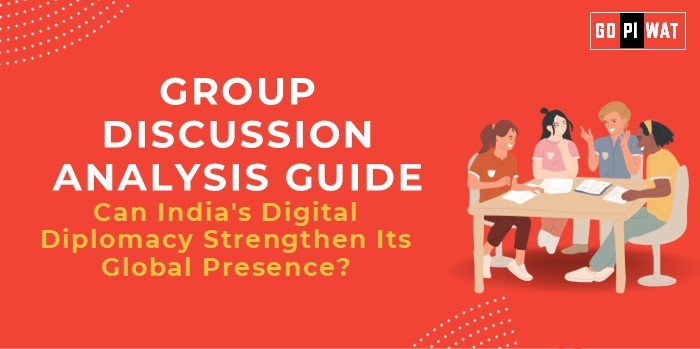📋 Group Discussion (GD) Analysis Guide
🌐 Can India’s Digital Diplomacy Strengthen Its Global Presence?
🌍 Introduction
In the digital age, diplomacy extends beyond traditional channels, embracing technology to foster global collaboration. India’s digital diplomacy, underpinned by initiatives like UPI, aims to enhance its international standing by offering technological solutions to developing nations. The potential for India’s digital tools to bridge global divides and strengthen partnerships places it at the forefront of global digital leadership.
📊 Quick Facts & Key Statistics
- 💳 UPI Transactions: In November 2024, UPI processed 15.48 billion transactions worth ₹21.55 trillion, reflecting India’s robust digital payment system.
- 🌐 Internet Users: As of January 2024, India had 751.5 million users, achieving 52.4% penetration.
- 🤝 Global Leadership in Digital Public Goods: NPCI is collaborating with over 20 countries to implement UPI-like systems by 2027.
- 🤖 AI Readiness Index: Ranked 32nd in 2022 among 181 countries, showcasing India’s expanding AI capabilities.
🤝 Stakeholders and Their Roles
- 🏛️ Government: Drives policy, oversees technology exports, and ensures infrastructure development.
- 💻 Private Sector: Innovates in technology, collaborates internationally, and supports scalability of solutions.
- 🌍 International Organizations: Facilitates standardization and ethical frameworks for digital governance.
- 🌐 Global Partners: Develop and adapt India’s digital solutions to local contexts, boosting bilateral relations.
📈 Achievements and Challenges
🏆 Achievements:
- ✔️ Digital Payments: UPI’s success, with 15.48 billion transactions monthly, positions India as a leader in financial inclusion.
- 🌎 Global Outreach: Collaborations in Africa and South America enhance India’s soft power.
- 🤖 Technological Innovation: Ranking in AI readiness highlights India’s growing expertise in cutting-edge technology.
⚠️ Challenges:
- 📉 Digital Divide: Only 52.4% internet penetration, with rural areas lagging behind.
- 🔒 Cybersecurity Risks: High-profile cyberattacks like AIIMS highlight vulnerabilities.
- 🌏 Global Competition: Other nations, such as China, offer competing technological solutions.
🗣️ Effective Discussion Approaches
💬 Opening Techniques:
- 📊 “With over ₹21.55 trillion in UPI transactions in November 2024, India showcases its global potential in digital payments.”
- 🔄 “India’s digital diplomacy is thriving globally, but domestically, only 52.4% internet penetration reveals gaps.”
🤔 Counter-Argument Handling:
- 🔐 Address cybersecurity challenges by highlighting India’s investment in CERT-In and global partnerships on cybersecurity frameworks.
📌 Strategic Analysis of Strengths & Weaknesses
✅ Strengths:
- ✔️ Proven digital solutions like UPI.
- 📊 Growing AI readiness.
- 🤝 International collaboration.
❌ Weaknesses:
- 📉 Limited rural digital connectivity.
- ⚠️ Cybersecurity threats.
🌟 Opportunities:
- 🌍 Expanding into untapped regions.
- 🤖 AI integration in diplomacy.
⚠️ Threats:
- 📊 Competition from China and other tech leaders.
- 🔒 Rising cyber threats.
📚 Structured Arguments for Discussion
- 🟢 Supporting Stance: “India’s UPI success globally exemplifies its potential to lead digital diplomacy initiatives.”
- 🔴 Opposing Stance: “Without addressing domestic challenges, India risks limiting its global digital ambitions.”
- ⚖️ Balanced Perspective: “India’s digital diplomacy combines notable successes and critical challenges, requiring a dual focus on domestic and global strategies.”
🎓 Connecting with B-School Applications
📖 Real-World Applications:
- 🌐 Explore how digital diplomacy can expand India’s trade and international relations.
❓ Sample Interview Questions:
- 💬 “What strategies can India adopt to enhance its global digital presence?”
- 🤔 “How can digital diplomacy contribute to India’s economic growth?”
💡 Insights for B-School Students:
- 📘 Link to global expansion strategies and innovation in tech-based diplomacy.


